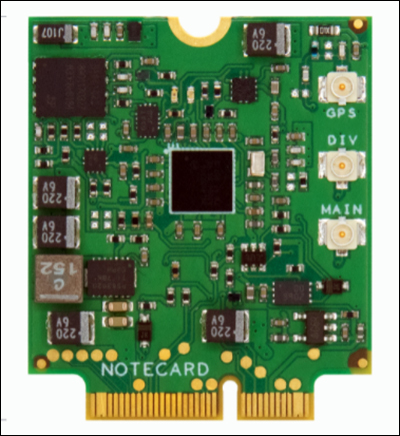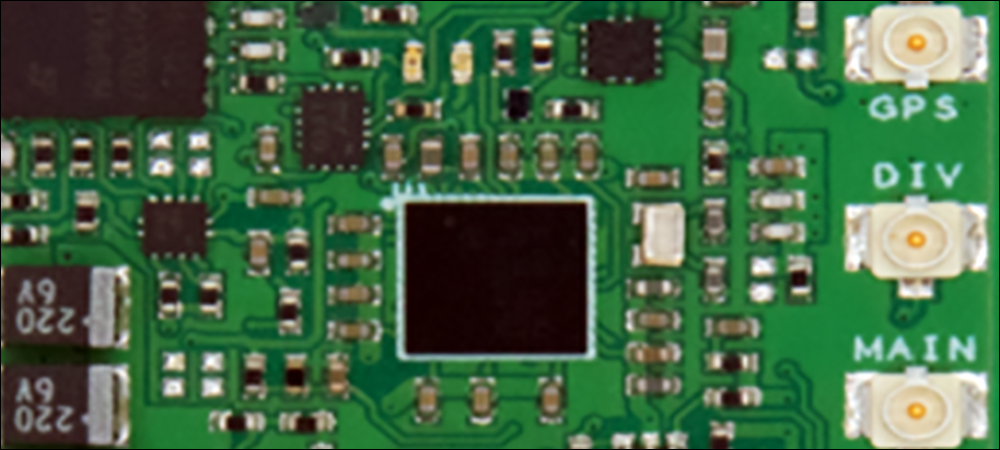Telecommunications equipment supplier Blues Wireless is aiming to make cellular-based Internet of Things (IoT) systems affordable and easy to deploy, with a solution called Notecard. Several companies have been piloting or deploying the technology since January 2020 for solutions ranging from air-quality measurements to supply chain tracking. Blues Wireless designed the system to enable developers to bring wireless connectivity to regular devices and solutions at a lower cost and with greater ease of deployment than for standard IoT systems.
The company is collaborating with semiconductor firm STMicroelectronics. The resultant Notecard system comes with 10 years of prepaid cellular connectivity from AT&T Wireless and leverages ST’s microcontroller (MCU) and secure element (SE). It can also provide temperature and motion sensing when an ST sensor known as the LIS2DTW12 is built into the device. In that way, users could implement applications such as tracking conditions in a cooler or cold supply chain, as well as enabling power optimization, by setting the Notecard to wake up when it senses motion.

The Notecard
Blues Wireless is a Boston-based startup that was three years in the making before its launch this past January. The company was founded by software executive Ray Ozzie, who was previously behind the Lotus Nodes group messaging platform in the 1980s. Ozzie launched and sold two startups to Microsoft: Groove Networks in 2005 and Talko in 2015. He also served as Microsoft’s chief software architect and launched its Azure cloud-computing platform.
Ozzie’s interest in the IoT dates back more than a decade. He had brought a technology innovation to Japan following that country’s 2011 earthquake and the subsequent nuclear accident at Fukushima Daiichi. While in Japan, he’d set up a cellular-based IoT system to capture radiation data using cloud-based wireless IoT sensors, in an attempt to provide real-time monitoring of conditions around the damaged plant, according to Mobeen Khan, Blues Wireless’ chief operating officer. In planning the launch of Blues Wireless, Ozzie met with Khan (then an AT&T strategist for IoT product management) to discuss how to organize a company dedicated to low-cost, easy-to-deploy IoT systems.
When the duo considered the Notecard solution, Khan recalls, “The idea was to make it 10 times less costly and 10 times less complex [for developers] to embed wireless connectivity into products.” A standard IoT connection to a non-connected system requires the purchasing of a variety of components, he explains, including a modem and a SIM card, and then finding a network from a cellular operator—or numerous operators if users intend to employ the system globally. “So our goal was to get this down to two lines of code,” he states, “and get the developer up and running, sending that data from a coffee maker [for instance] to the cloud in less than an hour.”
To accomplish this goal, STMicroelectronics’ engineers met with Ozzi to plan the hardware development. “Ray Ozzie has had exposure to ST division managers and leaders in the field for years, so it’s been a very collaborative environment since day one,” says John Perry, a sales engineer at Synergy, ST’s manufacturing representative. Perry recalls early discussions with Ozzie that were centered around philanthropic efforts and the development of a solution—since dubbed SafeCast—that could measure radioactivity levels. After considering multiple technology options, Blues Wireless chose to create a system independent of Wi-Fi networks. “Wi-Fi is a noisy, busy environment,” Perry says, “so he wanted to harness cellular particularly, because it has evolved to enable a low-power, low-bandwidth option.”
STMicroelectronics provides a portfolio of electronics and semiconductors. “Our microcontroller family is broad and wide,” says Robert Doyle, the company’s manager for the Northeast United States, “and our objective was to dial in the lowest-power device that was also feature-rich, high-performance and low-cost.” The Notecard solution is a 500 MB system-on-module using the STM32L4R5 ultra-low-power MCU and STSafe secure element to provide authentication and security, in order to protect against cloning, counterfeiting, malware injection and unauthorized production. The LIS2DTW12 is a MEMS digital output motion and temperature sensor, Doyle says, that is “optimal for those requiring the built-in sensing functionality.” The Notecard also uses several ST protection devices for electro-static protection.

Mobeen Khan
AT&T’s network provides cellular connectivity that operates in 120 or more countries. Blues Wireless is offering the card with an open-source file format (JSON) application programming interface. A variety of developers have already deployed systems since the Notecard was released earlier this year. For example, one company has developed an air quality monitoring device leveraging the Notecard sensor with additional built-in sensors to measure pollutant levels in the air. As it captures changes in air quality, the device can forward the collected data via the cellular connectivity to a cloud-based server, where the information could then be viewed by cities or other local governments, or by members of the public.
Blues Wireless is currently in conversations with several city and state governments that are seeking to use the device around schools and playgrounds to let people view air-quality levels, while another customer is deploying the system with a radiation sensor to detect conditions around nuclear plants. The Notecard is also being deployed for early fire-detection applications. The devices can be mounted in wildfire-vulnerable areas, such as forested locations near roadways, and can capture rises in temperature or detect smoke. It will then send that data to the cloud to help users identify a fire before it can grow out of control.
In the healthcare sector, some companies are building the Notecard technology into devices for monitoring cancer patients to measure muscle strength during exercise, enabling them to gain information about their recovery progression. The solution is also part of a diabetes-monitoring system, with sensors that transmit data via Bluetooth to the Notecard device, which then acts as a gateway, forwarding data to the cloud. And in the agriculture market, developers are using a Bluetooth configuration that links soil sensors, which measure moisture around a plant’s roots, to the Notecard gateway.
The Notecard device costs approximately $49 to $59. Blues Wireless also makes carrier boards with interfaces, such as USB ports, to enable the attachment of other sensors. “Just to make things easy,” Khan says, “we offer these developer boards.” In the long term, the company expects that as products are built in high volumes, developers will create their own boards. The solution is offered with the options of LTE-Cat M1 and NB-IoT. The latter uses a very narrow bandwidth (200 kHz), as opposed to Cat-M1, which uses 1.4 MHz. The maximum data rate for NB-IoT is thus around 250 kilobytes per second, whereas Cat-M1 can accomplish up to 1 megabyte per second. As a result, he says, Cat-M1 can support faster data transfer.
Those using the Notecard system so far, Khan reports, have included developers, product manufacturers and engineers embedding communication functionality into various everyday products. The collaboration with STMicroelectronics, he explains, means the company has achieved the low-power goals for which it was striving. “This device is incredibly low-power, with an unprecedented low quiescent current,” he states. “It’s sipping current, which is a big differentiator.”
For STMicroelectronics, Doyle says, the collaboration has been beneficial as well. Developers purchasing the Notecard system have been approaching the company seeking the necessary external sensors and MCUs specific to the applications they are building.


